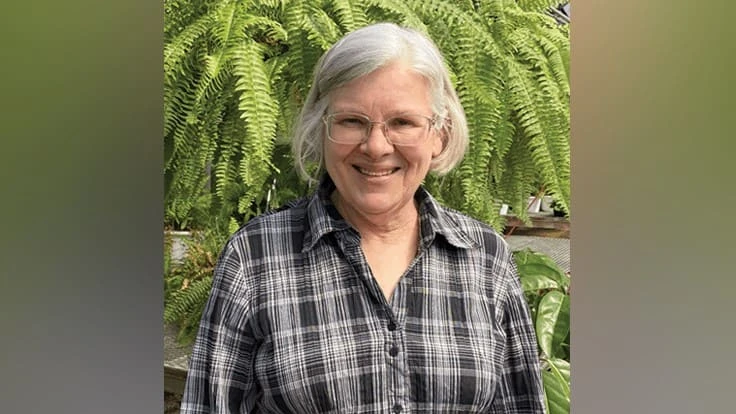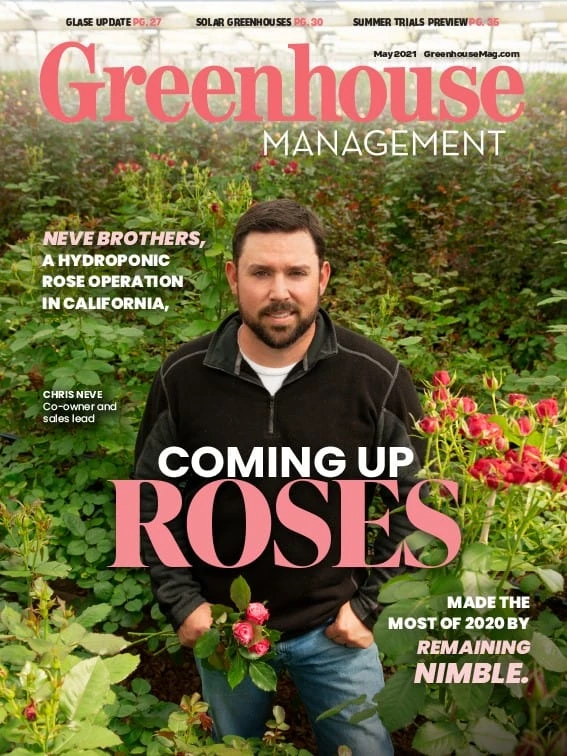

As her last name suggests, Diane Green was destined to end up in the greenhouse industry. Yet, that wasn’t the original plan when she graduated from Kent State University with a degree in vocational home economics, or even when she started working in DeHoff’s flower shop 43 years ago.
Initially, Green was going be a high school home economics teacher, but after a year of looking for jobs while substitute teaching, she decided to apply at DeHoff’s in Alliance, Ohio, where her brother worked. She started out wrapping Easter lilies and transplanting seedlings. By summer, she was making floral arrangements, and before long, she was managing the whole flower shop.
Green focused solely on flowers for about 20 years, until DeHoff’s head grower left the greenhouse division. Seeing an opportunity to improve the production of plants she was selling in the shop, Green took on the added responsibilities of growing. Now, in her dual role as manager of both the flower shop and the greenhouse, Green oversees the entire product lifecycle to produce beautiful plants for DeHoff’s customers.
Striking a balance
Although there is some overlap between her two roles, Green works long hours managing both the flower shop and the greenhouse operation at DeHoff’s.
“One of my biggest challenges is finding time to get everything done,” says Green, who relies on her team for help. In the flower shop, she’s assisted by two retail employees as well as an office manager. In the greenhouse, depending on the season, she has three or four “excellent greenhouse girls who take care of the work,” such as spraying, pinching, watering, and transplanting.
Green spends most of her day in the flower shop, serving customers and designing floral arrangements, but most days begin and end in the greenhouse. First thing in the morning, she meets with her growing team to “get the girls going with what they need to do that day,” she says. Green leaves written instructions to keep her team on track while she’s in the flower shop, and stops in at least three or four times a day to check their progress.
The greenhouse produces plant material to supply DeHoff’s other divisions, which include the flower shop, a garden center, and a full-service landscaping business (hence the official name, DeHoff’s FGL Inc., which stands for Flowers, Greenhouse and Landscaping). With 29,000 square feet of space, Green grows everything from poinsettias and Easter lilies to annuals, perennials, houseplants, and succulents.
“We’re so diverse,” she says, “which means we don’t have a whole greenhouse full of marigolds. I’m raising marigolds with petunias and geraniums, and they all have different growing requirements.”
Striking the balance to successfully grow a diverse crop mix requires some creativity — which, as a floral designer, is one of Green’s defining characteristics.

Creative time savers
To be effective at managing both divisions, Green has to be efficient with her time.
“One of my primary goals when I took over the greenhouse was to figure out how to grow an excellent crop without spending too much time doing it,” she says.
For example, Green doesn’t have time to spray six applications of pesticide on every Easter lily crop. Instead, she looks for time-saving tricks and alternative solutions —using plants and even bugs to her benefit.
“I’m trying to do more with bio-organic controls, so we’ve been using nematodes,” Green says. “That saves me some time, because if I can keep (pest populations) down with a simple release of nematodes, then I don’t have to spray.”
“When I walk out in the evening to close the greenhouse, it’s like going out to my own big garden to relax. It’s like my baby ... I like ... being creative with plants." —Diane green
So far, Green has had “fairly good success” controlling harmful pests with nematodes. Now, she’s also experimenting with some plant-based alternatives for pest control, like “using lemony-scented plants as bug repellants.”
“Last year, I put them down through the middle of my petunias, and I had pretty good success keeping the aphids off,” she says. “One year I tried raising banker plants (which provide supplemental food for beneficial insects) to keep it more natural and save some time. If they’re taking care of it, then I don’t have to work so hard.”
Full circle
Green believes that her dual role at DeHoff’s puts her in a prime position to meet customers’ needs by focusing on quality throughout the plant’s lifecycle. Since she’s responsible for everything from crop planning and growing decisions to making floral arrangements, the final product is literally in her hands.
“When I walk out there in the evening to close the greenhouse, it’s like going out to my own big garden to relax. It’s like my baby,” Green says. “I like making pretty things and being creative with plants.”
And she doesn’t plan to stop anytime soon. “Maybe someday I’ll retire,” says Green, 68. “And then maybe I can just go back to watering and transplanting, and then I’ll have gone full circle, right back to where I started from.”

Explore the May 2021 Issue
Check out more from this issue and find your next story to read.
Latest from Greenhouse Management
- Anthura acquires Bromelia assets from Corn. Bak in Netherlands
- Top 10 stories for National Poinsettia Day
- Langendoen Mechanical hosts open house to showcase new greenhouse build
- Conor Foy joins EHR's national sales team
- Pantone announces its 2026 Color of the Year
- Syngenta granted federal registration for Trefinti nematicide/fungicide in ornamental market
- A legacy of influence
- HILA 2025 video highlights: John Gaydos of Proven Winners





